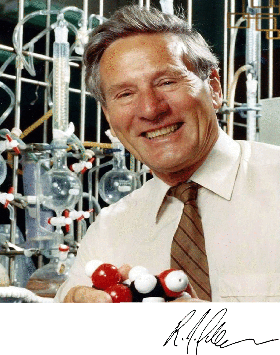Ronald Gillespie facts for kids
Quick facts for kids
Ronald Gillespie
|
|
|---|---|
 |
|
| Born |
Ronald James Gillespie
21 August 1924 London, United Kingdom
|
| Died | 26 February 2021 (aged 96) Dundas, Ontario, Canada
|
| Alma mater | University College London |
| Known for | VSEPR Theory |
| Awards |
|
| Scientific career | |
| Fields | Chemistry |
| Institutions | University College London McMaster University |
| Thesis | Cryoscopic studied in sulphuric and nitric acids (1949) |
| Doctoral advisor | Sir Christopher Ingold |
Ronald James Gillespie (August 21, 1924 – February 26, 2021) was an important British chemist. He was an expert in understanding the shapes of molecules. He moved to Canada because he was offered his own lab with new equipment. This was something that post-World War II Britain could not provide. He helped set up how inorganic chemistry was taught in Canada.
Contents
Early Life and Education
Ronald Gillespie was born in London, United Kingdom. He studied at the University of London. He earned his first degree in 1945. Later, he received his Ph.D. in 1949 and a D.Sc. in 1957. From 1950 to 1958, he worked as a lecturer at University College London in England.
Moving to Canada
In 1958, Gillespie moved to McMaster University in Hamilton, Ontario, Canada. He passed away on February 26, 2021, at 96 years old. He died in Dundas, Ontario, a town near Hamilton.
Awards and Recognition
Ronald Gillespie received many honors for his work. He became a Fellow of the Royal Society of Canada in 1965. In 1977, he was made a Fellow of the Royal Society of London. This is a very high honor for scientists. In 2007, he was given the Order of Canada. This is one of Canada's highest awards for citizens.
His Big Ideas in Chemistry
Gillespie did a lot of work on how molecules are shaped. He helped expand an idea called the Valence Shell Electron Pair Repulsion (VSEPR) model. He worked on this with another scientist, Ronald Nyholm. That's why it's also known as the Gillespie-Nyholm theory.
VSEPR Theory Explained
The VSEPR theory helps us predict the 3D shape of molecules. It says that pairs of electrons around a central atom try to get as far away from each other as possible. This is because electrons have negative charges and repel each other. Imagine balloons tied together; they naturally spread out. Molecules do the same thing with their electron pairs. Gillespie helped set the rules for using this theory. He also wrote several books about VSEPR.
Other Contributions
With other scientists, Gillespie also developed LCP theory. LCP stands for "ligand close packing." This theory helps predict molecule shapes based on how "ligands" (atoms or groups attached to a central atom) push away from each other.
He also studied the covalent radius of fluorine. A covalent radius is like half the distance between two atoms that are bonded together. Figuring out the covalent radius for fluorine is tricky. This is because fluorine is very "electronegative" (it pulls electrons strongly) and has a very small atomic radius. Gillespie's work helped understand fluorine's covalent radius by looking at how it bonds with different atoms.

